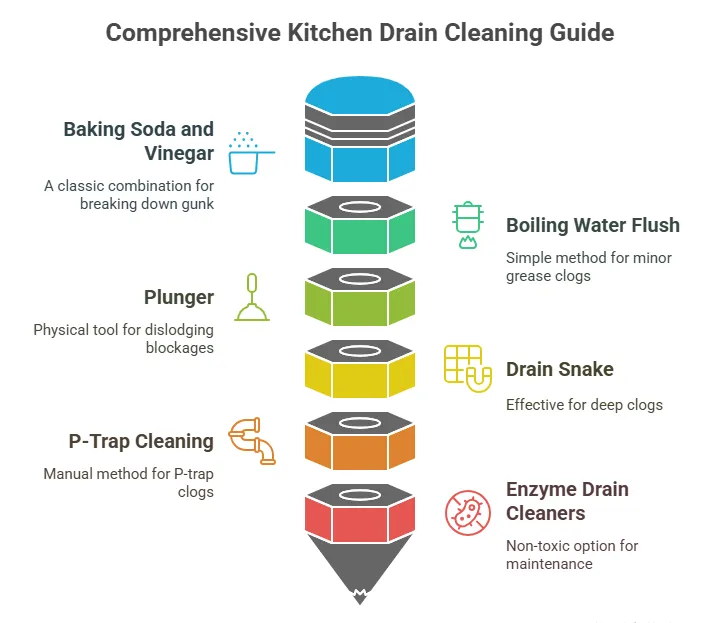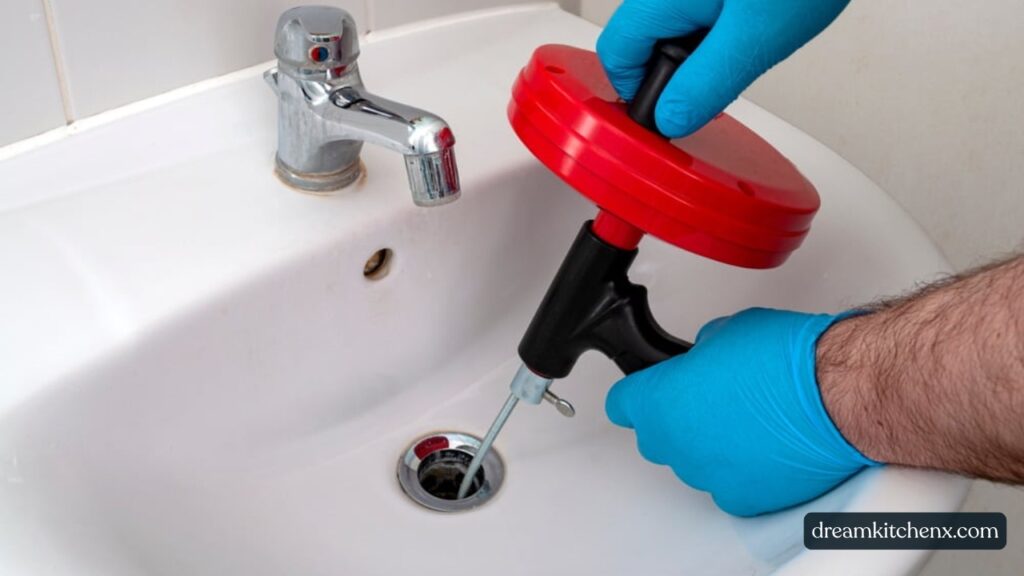How to clean kitchen sink drain? Well, cleaning your kitchen sink drain involves simple DIY methods like using baking soda and vinegar for clogs, boiling water for grease, or a plunger for blockages. Regular maintenance prevents odors and buildup, keeping your drain clear and fresh.
Is your kitchen sink draining slowly, smelling a bit off, or worse—completely clogged? You’re not alone! A troublesome kitchen drain is a common and frustrating problem. Luckily, you don’t always need a plumber to fix it. This guide will show you easy, practical, and often natural ways to get your kitchen sink drain flowing smoothly again. Let’s dive into effective solutions and preventative tips to keep your drain clean and odor-free.
Understanding Your Kitchen Sink Drain

Your kitchen sink drain works hard every day, but it’s also a common spot for problems to start. Understanding why drains get dirty can help you prevent clogs and odors.
Common Causes of Clogs & Odors
Many things go down your kitchen sink that shouldn’t, leading to issues over time.
Food particles: Tiny bits of food, like coffee grounds, rice, or pasta, can build up and stick together, forming a sticky blockage.
Grease and oil buildup: When hot grease goes down the drain, it cools and hardens, clinging to the inside of pipes. This creates a sticky trap for other debris.
Soap scum and hair: While more common in bathroom sinks, soap scum can build up in kitchen drains, especially if you wash greasy pans with lots of soap. Stray hair can also get caught.
Mineral deposits (hard water): If you live in an area with hard water, minerals can leave deposits inside your pipes. Over time, these layers can narrow the pipes and make them more prone to clogs.
Foreign objects: Occasionally, small items like twist ties, rubber bands, or even small toys can accidentally fall down the drain and cause an immediate blockage.
Signs You Need to Clean Your Drain
Your drain will often tell you when it needs attention. Look out for these common signs:
Slow drainage: If water takes longer than usual to go down, it’s a clear sign of a partial clog forming.
Unpleasant odors: A persistent smell coming from your drain usually means food particles are rotting or bacteria are growing inside the pipes.
Gurgling sounds: Strange gurgling or bubbling noises when water drains can indicate air being trapped by a partial blockage.
Standing water: This is the most obvious sign of a complete blockage. Water will fill the sink and refuse to go down.
Essential Tools & Safety Precautions
Before you start tackling your drain, it’s good to have some basic tools ready. Also, remember that safety comes first, especially when dealing with drains.
Basic Tools
Here are the simple tools you might need for cleaning your kitchen sink drain:
Rubber gloves: Protect your hands from grime and cleaning solutions.
Bucket: Useful for catching water if you need to open the P-trap.
Old toothbrush/small brush: Great for scrubbing around the drain opening or inside the P-trap.
Plunger: A basic yet powerful tool for dislodging many types of clogs.
Allen wrench: If you have a garbage disposal, an Allen wrench (usually 1/4 inch) is often used to reset it or free a jam from the bottom.
Safety First!
Always keep these safety tips in mind when cleaning your drain:
Never mix chemical drain cleaners: Combining different chemical products can create dangerous fumes or reactions. For instance, mixing bleach and ammonia can create toxic chloramine gas.
Protect eyes and skin: Wear safety glasses and gloves, especially if using any stronger cleaning agents.
Ventilate the area: Open windows or turn on an exhaust fan to ensure good airflow, particularly when odors are present or if using products with fumes.
Avoid harsh chemicals if you have a septic system: Many chemical drain cleaners can harm the beneficial bacteria in a septic system, leading to bigger problems down the line. Stick to natural methods.

Natural & DIY Methods for Cleaning Your Kitchen Sink Drain
You don’t always need harsh chemicals to get your kitchen sink drain clean. Many common household items can effectively tackle clogs and odors.
A. The Baking Soda and Vinegar Power Duo
This classic combination is a go-to for many drain issues. It’s safe, natural, and creates a fizzing action that can break down gunk.
Method:
- Remove any standing water from the sink.
- Pour half a cup to a full cup of baking soda directly down the drain.
- Follow it with half a cup to a full cup of white vinegar.
- You’ll hear a fizzing sound. This is the chemical reaction at work. Place a drain stopper or cover over the drain to keep the reaction focused inside the pipe.
- Let it sit for at least 30 minutes, or even overnight for tougher clogs.
- After the waiting period, pour a kettle of boiling water down the drain to flush everything away.
Why it works: The baking soda (a base) and vinegar (an acid) react to produce carbon dioxide gas. This gas creates pressure and bubbles, helping to dislodge and break down greasy buildup and food particles stuck in the drain.
B. The Boiling Water Flush
This is the simplest method and often effective for minor grease clogs.
Method:
- Boil a kettle full of water.
- Carefully pour the boiling water directly down the drain in two or three stages, allowing a few seconds between pours.
This method is especially useful for breaking down hardened grease. However, avoid this if you have PVC pipes that are old or known to be weak, as very hot water could potentially damage them over time.
C. Using a Plunger for Stubborn Clogs
A plunger is a powerful physical tool that uses suction to dislodge blockages.
Method:
- Remove the drain stopper.
- Fill the sink with enough water to cover the rubber cup of the plunger. This creates a seal.
- Place the plunger directly over the drain, ensuring a tight seal.
- Pump the plunger vigorously up and down 10-20 times, maintaining the seal.
- Quickly pull the plunger up to break the seal.
- If the water doesn’t drain, repeat the process.

D. The Drain Snake / Plumbing Snake
For deeper clogs that a plunger can’t reach, a drain snake (also called a plumbing auger) can be very effective.
When to use: Use a drain snake for clogs that are deep within the pipes, beyond the reach of plungers or natural solutions. These are often caused by tangled hair, larger food masses, or objects.
How to use:
- Feed the end of the snake into the drain opening.
- Push the snake slowly, turning the handle as you go. You’ll feel resistance when you hit a clog.
- Once you feel the clog, twist the snake and push it gently to break it up or hook onto it.
- Slowly pull the snake back out, pulling the clog with it.
- Run hot water to flush the drain and ensure it’s clear.
Cautionary notes: Be careful not to force the snake, as it can potentially scratch or damage pipes if used too aggressively. Also, always wear gloves, as the snake will come out dirty.
E. Cleaning the P-Trap (Manual Method)
The P-trap is the curved pipe directly under your sink. It’s designed to hold a small amount of water to prevent sewer gases from coming up, but it’s also where many clogs settle.
When necessary: If all other methods fail, the clog is likely in the P-trap itself.
Instructions:
- Place a bucket directly underneath the P-trap to catch any water or debris.
- Using a pipe wrench or pliers, carefully loosen the slip nuts on both ends of the P-trap.
- Remove the P-trap. Water and gunk will fall into the bucket.
- Clean out the P-trap thoroughly. You can use an old toothbrush, a small bottle brush, or even a wire coat hanger to remove any sludge or debris.
- Inspect the pipes leading to and from the P-trap for any visible blockages.
- Reattach the P-trap, making sure the slip nuts are tightened securely but not overtightened (this can crack plastic pipes).
- Run water to check for leaks.
F. Enzyme Drain Cleaners (Gentle Option)
Enzyme drain cleaners are a non-toxic alternative to harsh chemical cleaners. They work by using beneficial bacteria and enzymes to break down organic matter in your drain.
How they work: Unlike chemical cleaners that create a reaction, enzyme cleaners digest fats, grease, proteins, and carbohydrates that cause clogs and odors. They literally “eat” away at the buildup.
Pros & Cons:
| Pros | Cons |
|---|---|
| Safe for pipes and septic systems | Work slowly; not for immediate, severe clogs |
| Environmentally friendly | Require regular application for maintenance |
| Eliminates odors at the source | Less effective on inorganic materials (e.g., hair) |
| Good for long-term drain maintenance |
They are generally best used for preventative maintenance and to eliminate odors, rather than for clearing a completely blocked drain. Follow the product’s instructions carefully for the best results.
Conclusion
Keeping your kitchen sink drain clean and clear is essential for a hygienic home and to prevent costly plumbing issues down the line. As we’ve explored, knowing how to clean kitchen sink drain effectively involves a range of methods, from simple DIY solutions like baking soda and vinegar, to using tools like plungers and drain snakes for tougher clogs. Regular maintenance and mindful habits, such as avoiding pouring grease down the drain and using drain screens, are your best defense against future blockages and unpleasant odors. By following these practical tips, you can ensure your kitchen sink remains a functional and fresh part of your home, saving you time, money, and hassle.